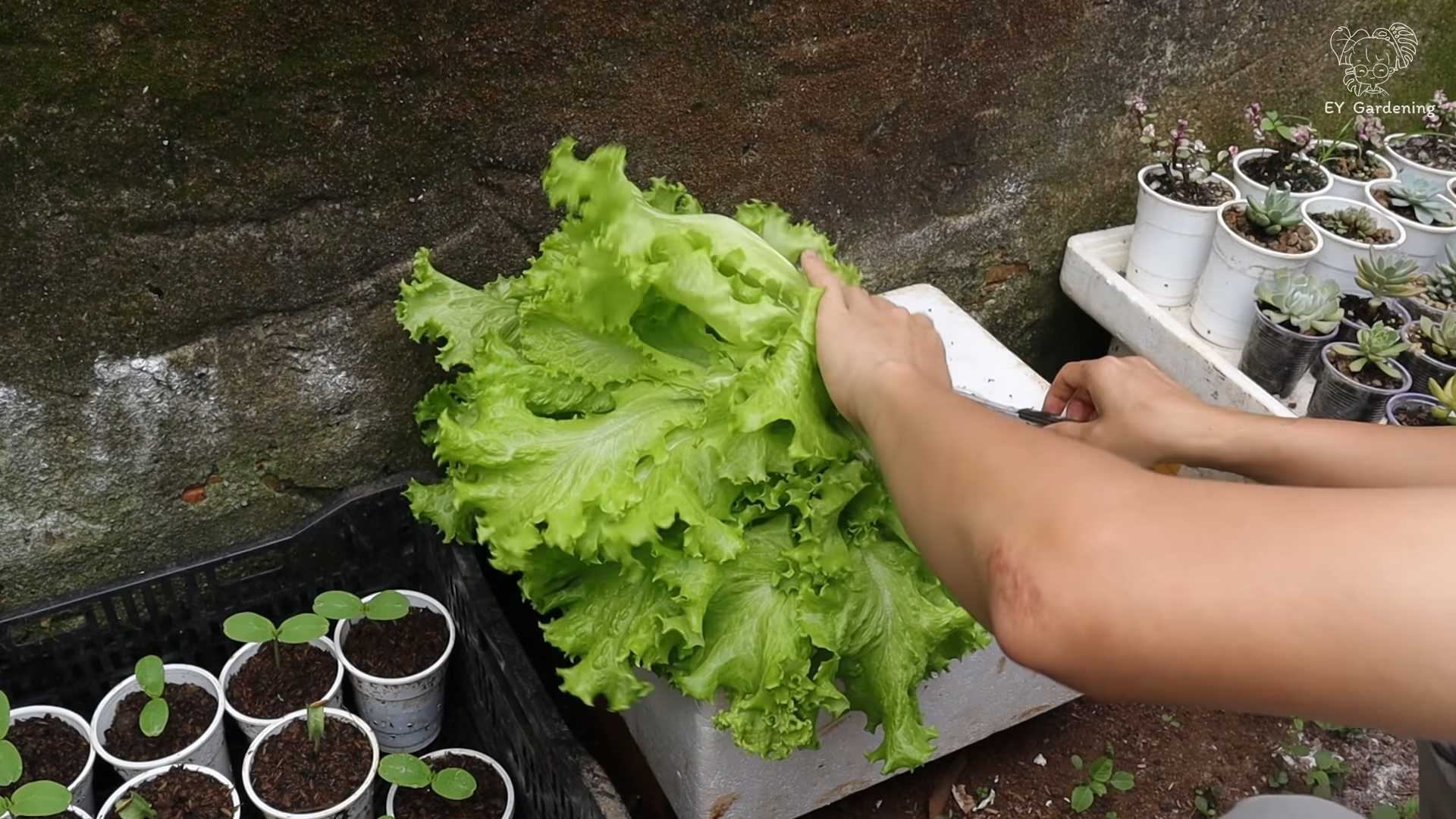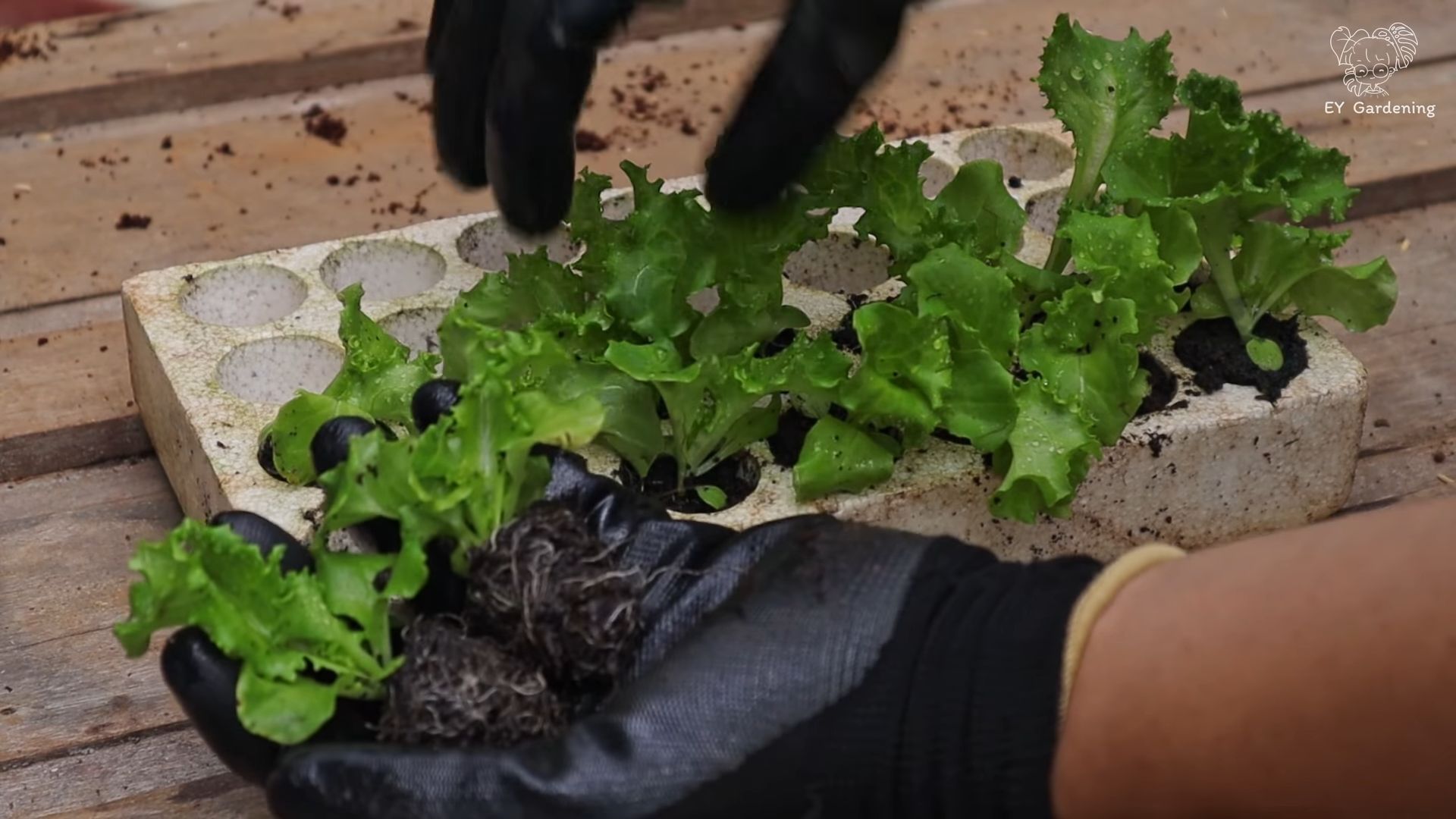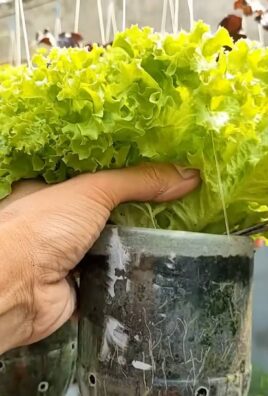Grow Lettuce at Home, and unlock the secrets to fresh, vibrant salads right outside your door! Imagine stepping into your garden and harvesting crisp, flavorful lettuce leaves whenever you desire. No more trips to the grocery store for wilted, overpriced greens. This isn’t just a dream; it’s an achievable reality with a few simple DIY tricks and hacks.
The practice of cultivating lettuce dates back to ancient times, with evidence suggesting its cultivation in ancient Egypt. Over centuries, lettuce has evolved from a wild plant to a diverse array of varieties, enjoyed across cultures for its refreshing taste and nutritional benefits. Today, the desire to connect with nature and enjoy fresh, healthy produce has fueled a resurgence in home gardening, making growing your own lettuce more popular than ever.
Why should you embark on this leafy adventure? Well, for starters, homegrown lettuce tastes infinitely better than store-bought. Plus, you have complete control over what goes into your garden, ensuring your lettuce is free from harmful pesticides and chemicals. In this article, I’ll share my favorite DIY tricks and hacks to help you grow lettuce at home successfully, even if you have limited space or gardening experience. Get ready to transform your backyard, balcony, or even a sunny windowsill into a thriving lettuce patch!

Grow Your Own Delicious Lettuce: A Beginner’s Guide
Hey there, fellow gardening enthusiasts! Ever dreamt of having fresh, crisp lettuce right at your fingertips? Well, dream no more! Growing your own lettuce is surprisingly easy, even if you don’t have a sprawling garden. I’m going to walk you through everything you need to know to cultivate a thriving lettuce patch, whether you’re working with a backyard garden, a balcony, or even just a sunny windowsill. Let’s get started!
Choosing Your Lettuce Varieties
First things first, let’s talk lettuce types. There’s a whole world of leafy greens out there, and picking the right varieties for your taste and climate is key. Here’s a quick rundown of some popular choices:
* **Loose-leaf Lettuce:** These are the easiest to grow and harvest. They don’t form a head, so you can snip off leaves as needed. Think ‘Black Seeded Simpson,’ ‘Red Sails,’ and ‘Oak Leaf.’
* **Butterhead Lettuce:** Known for their soft, buttery texture and delicate flavor. ‘Buttercrunch’ and ‘Bibb’ are classic choices.
* **Romaine Lettuce:** The star of Caesar salads! Romaine lettuce has a crisp texture and a slightly bitter taste. ‘Paris Island Cos’ and ‘Dark Green Romaine’ are great options.
* **Crisphead Lettuce:** These form tight, round heads, like iceberg lettuce. They can be a bit more challenging to grow, but the reward is that satisfying crunch.
Consider your local climate when choosing your varieties. Some lettuce types are more heat-tolerant than others. If you live in a warmer area, look for varieties that are specifically bred for heat resistance.
Getting Started: Seeds vs. Seedlings
You have two main options for starting your lettuce garden: seeds or seedlings. Both have their pros and cons.
* **Seeds:** Starting from seed is more economical and gives you a wider variety to choose from. However, it requires a bit more patience and attention.
* **Seedlings:** Buying seedlings from a nursery is a quicker and easier option, especially for beginners. You’ll get a head start on the growing season, but you’ll be limited to the varieties that are available.
I personally prefer starting from seed because I love the feeling of nurturing a plant from its earliest stages. Plus, it’s a great way to save money!
Planting Your Lettuce: A Step-by-Step Guide
Okay, let’s get our hands dirty! Here’s how to plant your lettuce, whether you’re starting from seed or using seedlings:
1. **Prepare the Soil:** Lettuce thrives in well-drained, fertile soil. Amend your soil with compost or other organic matter to improve its texture and nutrient content. The soil should be loose and easy to work with. If you’re using containers, choose a high-quality potting mix.
2. **Sowing Seeds (if applicable):** If you’re starting from seed, sow the seeds about ¼ inch deep and 1 inch apart. Gently cover the seeds with soil and water thoroughly. Keep the soil consistently moist until the seeds germinate, which usually takes about 7-10 days.
3. **Thinning Seedlings (if applicable):** Once your seedlings have a few true leaves, thin them out to about 6-8 inches apart. This will give them enough room to grow and prevent overcrowding. Don’t just pull them out! Gently snip the unwanted seedlings at the soil line to avoid disturbing the roots of the remaining plants.
4. **Planting Seedlings (if applicable):** If you’re using seedlings, gently remove them from their containers and plant them at the same depth they were growing in the nursery. Space them about 6-8 inches apart.
5. **Watering:** Water your lettuce plants regularly, especially during dry spells. Lettuce needs consistent moisture to thrive. Aim to keep the soil moist but not waterlogged.
6. **Mulching:** Apply a layer of mulch around your lettuce plants to help retain moisture, suppress weeds, and regulate soil temperature. Straw, shredded leaves, or wood chips are all good options.
Caring for Your Lettuce: Keeping it Happy and Healthy
Now that your lettuce is planted, it’s time to give it some TLC. Here’s what you need to do to keep your plants happy and healthy:
1. **Watering:** As I mentioned earlier, consistent watering is crucial. Check the soil moisture regularly and water when the top inch feels dry. Avoid overhead watering, as this can lead to fungal diseases. Instead, water at the base of the plants.
2. **Fertilizing:** Lettuce is a relatively light feeder, but it will benefit from occasional fertilization. Use a balanced fertilizer or a fertilizer specifically formulated for leafy greens. Follow the instructions on the fertilizer package carefully. I like to use a liquid seaweed fertilizer diluted in water every few weeks.
3. **Weeding:** Keep your lettuce patch free of weeds. Weeds compete with lettuce for water and nutrients, and they can also harbor pests and diseases. Hand-pull weeds regularly, being careful not to disturb the roots of your lettuce plants.
4. **Pest Control:** Lettuce is susceptible to a few common pests, such as aphids, slugs, and snails. Inspect your plants regularly for signs of infestation. If you find pests, you can try hand-picking them off, spraying them with insecticidal soap, or using diatomaceous earth.
5. **Bolting Prevention:** Bolting is when lettuce plants send up a flower stalk and become bitter. This usually happens when the weather gets too hot. To prevent bolting, choose heat-tolerant varieties, provide shade during the hottest part of the day, and harvest your lettuce regularly.
Harvesting Your Lettuce: Enjoying the Fruits (or Leaves!) of Your Labor
The best part of growing your own lettuce is, of course, harvesting it! Here’s how to harvest your lettuce for the best flavor and texture:
1. **Harvesting Loose-leaf Lettuce:** You can start harvesting loose-leaf lettuce as soon as the leaves are big enough to eat. Simply snip off the outer leaves with scissors or a knife, leaving the inner leaves to continue growing. This is called “cut-and-come-again” harvesting, and it allows you to enjoy fresh lettuce for weeks.
2. **Harvesting Butterhead and Romaine Lettuce:** Harvest butterhead and romaine lettuce when the heads are firm and well-formed. Cut the head off at the base of the plant with a sharp knife.
3. **Harvesting Crisphead Lettuce:** Crisphead lettuce is ready to harvest when the heads are firm and dense. Cut the head off at the base of the plant with a sharp knife.
4. **Timing is Key:** Harvest your lettuce in the morning, before the sun has had a chance to heat up the leaves. This will help to keep them crisp and fresh.
5. **Storage:** Store your harvested lettuce in the refrigerator in a plastic bag or container. It will keep for several days.
Troubleshooting: Common Lettuce Problems and Solutions
Even with the best care, you might encounter a few problems along the way. Here are some common lettuce issues and how to fix them:
* **Yellowing Leaves:** Yellowing leaves can be caused by a variety of factors, including overwatering, underwatering, nutrient deficiencies, and pests. Check the soil moisture and adjust your watering accordingly. Fertilize your plants with a balanced fertilizer. Inspect your plants for pests and treat them as needed.
* **Wilting Leaves:** Wilting leaves are usually a sign of underwatering. Water your plants thoroughly and make sure the soil is well-drained.
* **Bitter Taste:** A bitter taste is often a sign of bolting. Choose heat-tolerant varieties, provide shade during the hottest part of the day, and harvest your lettuce regularly.
* **Pest Infestations:** As mentioned earlier, lettuce is susceptible to a few common pests. Inspect your plants regularly for signs of infestation and treat them as needed.
Growing Lettuce in Containers: A Great Option for Small Spaces
Don’t have a garden? No problem! You can easily grow lettuce in containers. Here’s what you need to know:
1. **Choose the Right Container:** Select a container that is at least 6 inches deep and wide. Make sure the container has drainage holes to prevent waterlogging.
2. **Use a High-Quality Potting Mix:** Avoid using garden soil in containers, as it can become compacted and poorly drained. Instead, use a high-quality potting mix that is specifically formulated for container gardening.
3. **Plant Your Lettuce:** Follow the same planting instructions as you would for growing lettuce in the ground.
4. **Water Regularly:** Container-grown lettuce tends to dry out more quickly than lettuce grown in the ground, so water it regularly. Check the soil moisture daily and water when the top inch feels dry.
5. **Fertilize Regularly:** Container-grown lettuce also needs to be fertilized more frequently than lettuce grown in the ground. Use a balanced fertilizer or a fertilizer specifically formulated for leafy greens.
6. **Provide Sunlight:** Lettuce needs at least 6 hours of sunlight per day. Place your container in a sunny location.
Extending Your Lettuce Season: Tips

Conclusion
So, there you have it! Growing lettuce at home is not only achievable, but it’s also incredibly rewarding. Imagine stepping out into your garden or even just onto your balcony and harvesting fresh, crisp lettuce leaves whenever you need them. No more last-minute trips to the grocery store or settling for wilted, pre-packaged greens. This DIY trick empowers you to take control of your salad bowl and enjoy the unparalleled flavor of homegrown produce.
But why is this a must-try? Beyond the convenience and superior taste, growing your own lettuce offers a connection to nature that’s often missing in our modern lives. It’s a therapeutic activity that can reduce stress and provide a sense of accomplishment. Plus, you know exactly what’s going into your food – no harmful pesticides or herbicides, just pure, natural goodness.
This is more than just growing lettuce; it’s about cultivating a healthier lifestyle.
Ready to take your lettuce game to the next level? Consider these variations:
* **Succession Planting:** Plant new seeds every two weeks to ensure a continuous harvest throughout the growing season. This way, you’ll always have fresh lettuce on hand.
* **Container Gardening:** If you’re short on space, lettuce thrives in containers. Choose a pot that’s at least 6 inches deep and wide, and use a well-draining potting mix.
* **Hydroponics:** For a more advanced approach, explore hydroponic lettuce growing. This method uses water and nutrients instead of soil, and it can be incredibly efficient.
* **Different Varieties:** Experiment with different lettuce varieties to find your favorites. From crisp romaine to buttery butterhead, there’s a lettuce out there for everyone. Try growing a mesclun mix for a variety of flavors and textures in every salad.
* **Vertical Gardening:** Maximize your space by growing lettuce vertically. Use a vertical planter or create your own using recycled materials.
Don’t be afraid to experiment and adapt this DIY trick to your own unique circumstances. The beauty of gardening is that there’s no one-size-fits-all approach. What works for one person may not work for another, so embrace the learning process and have fun with it!
We are confident that once you experience the joy of harvesting your own fresh lettuce, you’ll never go back to store-bought greens. It’s a simple, sustainable, and satisfying way to enhance your meals and connect with nature.
So, what are you waiting for? Grab some seeds, prepare your soil, and get ready to embark on your lettuce-growing adventure. We can’t wait to hear about your experiences! Share your photos, tips, and challenges in the comments below. Let’s create a community of home gardeners who are passionate about growing their own food. Happy gardening!
Frequently Asked Questions (FAQ)
What is the best time of year to grow lettuce?
Lettuce is a cool-season crop, meaning it thrives in temperatures between 60°F and 70°F (15°C and 21°C). The best time to plant lettuce is in early spring or late summer/early fall. Avoid planting during the hottest months of summer, as the heat can cause lettuce to bolt (go to seed), resulting in bitter-tasting leaves. If you live in a warmer climate, you can grow lettuce throughout the winter.
What kind of soil is best for growing lettuce?
Lettuce prefers well-draining soil that is rich in organic matter. Amend your soil with compost or aged manure before planting to improve its fertility and drainage. A slightly acidic soil pH of around 6.0 to 6.8 is ideal. You can test your soil pH with a home testing kit or by sending a sample to a local agricultural extension office.
How much sunlight does lettuce need?
Lettuce needs at least 6 hours of sunlight per day to grow well. However, in hotter climates, it can benefit from some afternoon shade to prevent bolting. If you’re growing lettuce indoors, use grow lights to provide adequate light.
How often should I water lettuce?
Lettuce needs consistent moisture to thrive. Water deeply whenever the top inch of soil feels dry to the touch. Avoid overwatering, as this can lead to root rot. Use a soaker hose or drip irrigation to water lettuce at the base of the plants, avoiding wetting the leaves, which can encourage fungal diseases.
How do I prevent lettuce from bolting?
Bolting is when lettuce plants send up a flower stalk and the leaves become bitter. To prevent bolting, choose bolt-resistant varieties, provide afternoon shade in hot weather, and water regularly. Harvest lettuce leaves frequently, as this can also help delay bolting.
What are some common pests and diseases that affect lettuce?
Common pests that affect lettuce include aphids, slugs, snails, and cutworms. You can control these pests with organic methods such as handpicking, using insecticidal soap, or applying diatomaceous earth. Common diseases that affect lettuce include downy mildew, powdery mildew, and leaf spot. Prevent these diseases by providing good air circulation, avoiding overhead watering, and using disease-resistant varieties.
How do I harvest lettuce?
You can harvest lettuce leaves as soon as they are large enough to eat. There are two main ways to harvest lettuce:
* **Cut-and-Come-Again:** Harvest the outer leaves of the plant, leaving the inner leaves to continue growing. This method allows you to harvest lettuce multiple times from the same plant.
* **Head Harvest:** Harvest the entire head of lettuce at once when it is fully mature.
Can I grow lettuce indoors?
Yes, you can grow lettuce indoors. Choose a sunny windowsill or use grow lights to provide adequate light. Use a well-draining potting mix and water regularly. Consider growing loose-leaf varieties, as they are easier to harvest indoors.
What are some good companion plants for lettuce?
Good companion plants for lettuce include carrots, radishes, onions, garlic, and marigolds. These plants can help deter pests, improve soil health, or provide shade. Avoid planting lettuce near fennel, as it can inhibit lettuce growth.
How do I store harvested lettuce?
To store harvested lettuce, wash and dry the leaves thoroughly. Wrap the leaves in a paper towel and store them in a plastic bag in the refrigerator. Lettuce can typically be stored for up to a week using this method.
What are the nutritional benefits of lettuce?
Lettuce is a good source of vitamins A and K, as well as folate and fiber. It is also low in calories and fat. Different varieties of lettuce have different nutritional profiles, so choose a variety that meets your specific needs.
Can I grow lettuce from seed?
Yes, growing lettuce from seed is easy and rewarding. Start seeds indoors 4-6 weeks before the last frost, or direct sow seeds outdoors as soon as the soil can be worked. Lettuce seeds need light to germinate, so sow them shallowly and keep the soil moist.
Is it possible to grow organic lettuce at home?
Absolutely! Growing organic lettuce at home is not only possible but highly recommended. By using organic soil amendments, pest control methods, and avoiding synthetic fertilizers and pesticides, you can ensure that your lettuce is free from harmful chemicals and full of natural flavor. This DIY trick is inherently suited to organic practices, allowing you to control every aspect of the growing process.




Leave a Comment